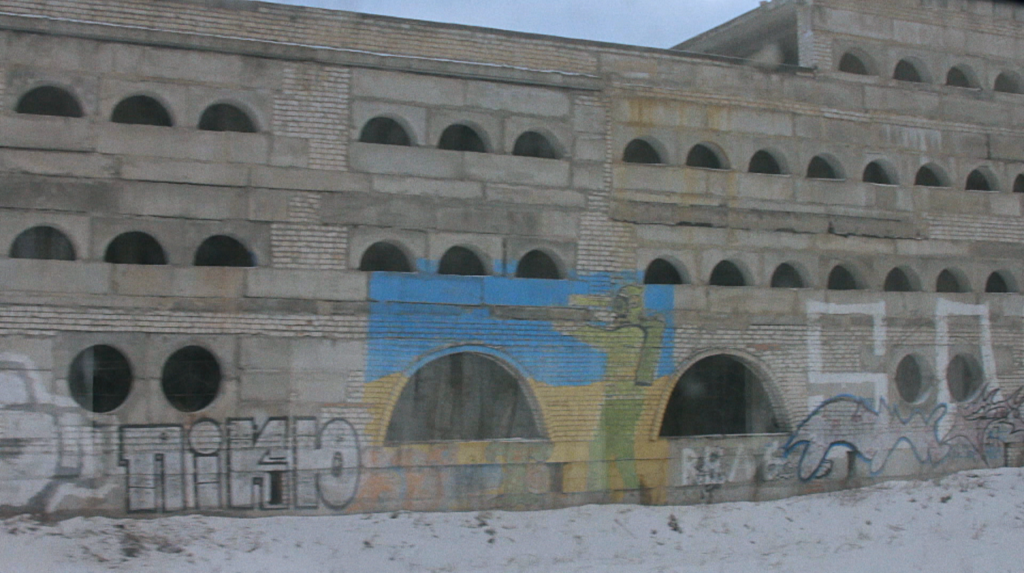Exodus from the post-Soviet Condition
A brief suggestion of decolonial perspective on contemporary art in Ukraine
When considering the state of art ‘in Ukraine now’, one may focus on the ‘now’, which frames the subject, or the ‘in Ukraine’ within that frame. The place which one describes with the term ‘in Ukraine’ proceeds from the intersection of the most amazing temporalities of social and political processes. It is a place that has been in a state of transit from historical socialism to liberal democracy for thirty years. At the same time, this place is already integrated into global social transformations and market metamorphoses; the collapse of the public sphere, the emergence of new precarious and hybrid forms of labor, the formation of affective governance (which actually allowed a comedian to become president), and active participation in global markets through outsourced Ukrainian labor as both migrant agricultural workers and remote IT specialists. There are geological layers to this place and the bodies that populate it—scars from the Stalinist and late-Soviet state biopolitics, weak dissident traces leading to independence, a huge crisis in the 1990s, early capitalist chic in the 2000s, two democratic revolutions, and traces of bullets and explosions.
Circulation (2020) by Oleksiy Radynski and concrete and unclear (2019) by fantastic little splash closely observe that diversity, which was paradoxically frozen into a moving image through the documentation of variability, or the desynchronization of the totality of the Imperial gaze, which, through media and visual practices in particular Eastern European contexts, is incorporated into a universal highway to the Kingdom of (Market) Reason. These two films embody the tendencies of coming out of the post-Soviet condition by focusing on relations between gaze, screen, imaged and imagined subject, rather than on heritage itself. Since I aim to extrapolate these tendencies (within a political horizon, where they may become a pattern for social practices), I would try to investigate the substance, which shimmers amidst these relations. I use the term ‘substance’ because of the great unsettlement, changeability, and multiplicity of its forms, and on account of both its emerging state and the absence of its theoretical formalizations on the epistemological radars of Western culture.

fantastic little splash, an art collective from the eastern Ukrainian city of Dnipro, works with the aforementioned ‘substance’. Their film concrete and unclear (2019), exists as a kind of artistic research into the materiality of the images surrounding the unfinished building of the huge Parus Hotel, the construction of which was suspended in 1989. The film observes a historical set of images and imaginaries surrounding the building.
The construction of the huge hotel (the total building volume of which is around 188,000 m2) was intended to celebrate “the greatness of the Soviet Union” in the city from which Leonid Brezhnev, the head of the state at that point, came. However, the construction was never finished. It remained abandoned and inhabited by flora only until 2014. During the Maidan Revolution the hotel was painted yellow and blue—a gestural crystallization of a specific collective affect that prevailed at the time; an affect that was something between hope and despair. Neoliberalism, the gruelingly long war in eastern Ukraine, the resulting political crisis, and the patriarchal reaction provoked in Ukrainian society by the Russian invasion in 2014 have linked the image of the Parus Hotel acts of suicide, or what Italian philosopher Franco Bifo Berardi refers to as a terrorism of the 21st century. The building clearly achieves the state conceptualized by Berardi—just after the end of the Cold War, which was a conductor of social violence, “suicide has come to be perceived increasingly as the only effective action of the oppressed, the only action which can actually dispel anxiety, depression and impotence”. In the end, the ‘concrete and unclear‘ materiality of the image of the building found its place in fantastic little splash’s film, that is, it is organized with a constant openness to multiple and discrete historical forms of the concrete substance. This opacity concerns the unsettled and unclear future of the Parus Hotel—what else can be imagined about it, if one does not want to access the constantly variable essence of its concrete structure?

As cultural critic Yustyna Kravchuk pointed out, due to the inability of Kyiv’s transport infrastructure to fulfill its intended purpose properly, Oleksiy Radynski found a new usage for it—as a dolly; a rail used for the horizontal movement of the camera. Raw everyday visual data appears in frame, which, according to Kravchuk, is the gaze of Walter Benjamin’s angelus novus—the fragments of the Soviet past, the recent onset of weird capitalist development, the scattered fragments of society disbursed throughout Kyiv by neoliberal reforms. However, as she immediately points out, the peculiarity of the flight path of this angel, which observes the devastating consequences of historical progress, is in the fact that it, like the Kyiv urban rail train, does not move forward, but in a circle. In this case, progress from fallen historical socialism to neoliberal capitalism takes the form of the destruction of the remnants of the public sphere, rather than the promised democracy and freedom. This precise view of such a ringed historical dynamic is a view from within its own movement, but also, at the same time, a view sufficiently distant to not give credence to ideological chatter about the future of the city, a prosperity which is supposedly provided by investment in the city’s development and other forms extending capitalist relations. The ambivalence established by the film; of distance and within-ness, of moving forward and in a circle, ensures openness to different historical trajectories of the former Soviet, a non-temporally linear concept which one might call the trans-Soviet.
What is assembled by these works, if Western visual culture encodes arrays of images and iconographic practices into historical chains in the cultural, political and social imagination? I call these kinds of collective practices “an Exodus from the post-Soviet condition”. Unlike many researchers who limit the concept of “the post-Soviet” to only Eastern European contexts, Susan Buck-Morss, an intellectual historian whose research projects are deeply concerned with paradoxical and problematic areas of Western aesthetic culture, states that the post-Soviet condition is a global one. It finds its origins in Western cultural hegemony, which were expressed in the Imperial Russian and subsequent Soviet agricultural and industrial modernization here in Ukraine. The post-Soviet condition is the state of Western culture, the last breath of a universal history that emerged after the end of the Cold War. Today, it seems appropriate that this state has led to a global extractivist consensus around Ukraine, as well as Belarus, Kazakhstan and the territories of Caucasus. All these territories, which in principle should be ‘neutral zones’ outside of NATO-type international military alliances, are still conceptualized as immature ‘students’ of major geopolitical players. However, paradoxically, the ‘lessons’ that the great powers transmit to their ‘students’ manifest as constant wars for extraction, which are always distant for Western Europe and US.
Instead of reiterating teleological liberal fantasies of the post-Soviet condition as a state of transition from socialism to capitalism, Buck-Morss writes; “Globalization refers to the recognition of this shared time: there is no part of global space that is “advanced” in time; none that is “backward”; we are all in this time that is both transient and universal; we share the same contingent history; we have equal rights to determine our common future.” Just as the post-Soviet condition turned out to be global, so too are the forms of popular uprising against those circumstances. As a scholar in the field of theoretical critique Olha Bryukhovetska notes, the Maidan revolution and the Occupy movements are quite similar in terms of the form of common action itself: an occupation of a main square, a self-organized infrastructural functioning of an occupied space, and an absence of strict or unified protester demands. This can hardly be denied, even through the later capture of Maidan’s agency by professional politicians who are the actors of another political formation (representative democracy), while the Occupy movements were simply exhausted into bifurcations (or rearrangements) of assemblies in most cases. In the post-industrial age, post-workerist philosopher Paolo Virno conceptualized the practice of a singular but non-universal common future, which is kept by those forms of uprisings as an exodus. An exodus does not fulfill any kind of universalist emancipatory agenda, but rather deals with the multiplicity of agendas in political experimentations. This sort of common action does not aim to take, or cede, power. It rather rearranges the entirety of power relations, as well as “forms of sociability, productive relations, knowledge, networks of our part.” These days, however, this agency accumulated through such common actions is usually absent on the epistemological radars of highly sophisticated leftist critique, which has largely been tainted by pessimism about post-capitalist futures.
In the field of art cinema, a common future occurs as Eisenstein’s “third meaning” (I refer to this Soviet avant-garde filmmaker because of his great impact on cinematic practices in Eastern Europe). In Eisenstein’s theory of cinematic montage “our common ground is to be found less in the convergence of these images than in the unbridgeable space that holds them apart”. But in spite of Eisenstein’s condition of Soviet enlightened authoritarianism, in the post-Soviet condition, the constellation of contemporary art, in its articulation as socially engaged moving image practice, has independently invented its own version of this space which holds images apart.
This space was introduced by an important feature which is common to both socially-engaged art and other contemporary avant-garde artistic practices where art discards the audience in order to explore another form of agency—that of the participant. However, in the field of images, precisely in its state of affective governance, a participant is not just an individual subject with his or her state of mind. A participant is a subjectivity introduced by the neoliberal market and digitalized biopolitics as a transindividual social, political and labor subjectivity. Investigating filmic practices, which were influenced by the impact of cybernetics on social and art fields, Ute Holl calls such kind of subjectivity “a network of to whom it may concern”. The relations between a spectator and a screen are not necessarily codified as a relation of simply observing. For an audience already concerned with the life of Dnipro and Kyiv, as well as of other former Soviet cities (for cultural workers, activists, alternative media workers, etc), concrete and unclear and Circulation require keeping an openness to the variety of non-neoliberal and non-universal historical fluxes. This openness is precisely the non-universalism that is determined by forms of collective political action without unified protesters’ demands, even if some of them are common for most of the actors. This is how the audience may be articulated as participants, although many of them may not be even an addressee of the films.
The images of these films are the unstable containers of abstract and (potential) diverse social relations. The participant may be considered as a substance that explores its own agency to be formed not as a stage of linear universal and historical flux, but as a multiplicity of fluxes, including ones that were unofficial or unfinished by the Soviet cultural project in its multiplicity. This substance—not yet formed—contains futures in particular. Astonishingly, exodus from the post-Soviet condition is rather trans- then anti-Soviet—it requires a critical observation of post-Soviet condition, just as taking a close look at minor traces of Soviet culture—unfinished or upcoming ones, which may become platforms of further assemblings, as with the Parus hotel. However, to come out of the post-Soviet condition also requires overcoming its most awful economic and geopolitical groundings—Russia’s wars for extraction and geopolitical domination, and the corruption of EU states by the Russian gas industry.
This article is largely based on the symposium paper for THE COLLECTIVE BODY DISMEMBERED: Histories of Art, Identities and the War in Ukraine, May 2022, Copenhagen.
Olexii Kuchanskyi is an independent researcher, film programmer, and writer whose main interests lie in experimental moving-image art, collective visual practices, their ecological impact, and critical cultures of nature. S/he was born in 1998 in Vinnytsia, Ukraine, studied at the Cultural studies department of Kyiv-Mohyla academy. His/her works have been published in Prostory, Your Art, TransitoryWhite, Political Critique, East-European Film Bulletin, Arts of the Working Class, Moscow Art Magazine, e-flux Notes, Theory on Demand, and others.
Published 24 November 2022
- The idea of affective governance was largely examined in contemporary political theory. Probably one of the most significant cases is Brian Massumi’s Ontopower: War, Powers, and the State of Perception (Durham: Duke University Press Books, 2015). I have partly observed the cases of affective governance in Ukraine previously: Susoiev, Y., Kuchanskyi, O. ‘Fear and Preemption: the Dictionary of Power Relations in the Age of Governing the Threats’ [In Ukrainian]. Political Critique (2021) and Kuchanskyi. O ‘Lockdown in the Glass House: Spasm, Ontopower, and Alice’ [In Ukrainian]. Your Art (2021).
- Here I refer to the roots of the ways in which East-European contexts are usually investigated. As seen by the gaze encoded by Enlightenment, by Kant’s articulation in particular, the region is usually discussed as an underdeveloped one, while the development itself is understood as driven by evolution of knowledge. Such paths of the history of philosophy have been largely criticized by decolonial theories. One of the most influential books in this regard is Mignolo, W. Local Histories / Colonial Design: Coloniality, Subaltern Knowledges, and Border Thinking. Princeton University Press (2000).
- Berardi, F. Heroes: Mass Murder and Suicide. Verso books (2015) p. 145
- Kravchuk, Y. “Pryvydy Kyiivskyh Ruin” [In Ukrainian]. Political Critique (2020)
- See the parallel and brief investigation of relations between Ukrainian conditions and Georgian ones elaborated by Keti Chukhrov: Chukhrov, K. ‘The NATO Conundrum’. e-flux Notes (2022). Asia Bazdyrieva observes the formation of such an agency-less subject in the gaze of Western colonialism: Bazdyrieva, A. No Milk, No Love. e-flux journal, Issue #127 (2022, March)
- Buck-Morss, S. ‘Theorizing Today: The Post-Soviet Condition’. Log, #11 (2008, Winter) p. 30
- Bryukhovetska, O. “European Spectres and Ukrainian Bodies, or What is Maidan?”. Internationale Online (2015).
- Virno, P. “General Intellect, Exodus, Multitude” Trans. Nate Holdren. Archipélago 54 (June 2002). (Republished by Generation Online. 6 Mar. 2008.)
- Buck-Morss, p. 31.
- These aesthetical formations were largely described and accelerated by Nicolas Bourriaud’s concept of relational aesthetics. Bourriaud, N. Relational Aesthetics. Paris: Presses du réel, (2002)
- Originally this term was introduced by cybernetics Nobert Wiener, while Ute Holl reintegrated it into the film theory. Holl, U. Cinema, Trans & Cybernetics. Amsterdam: Amsterdam University Press, (2017) P. 48.12. See the conceptual expansion of a similar intuition in Michal Murawski’s article on “trans-socialism”: Murawski, M. “Locating Trans-Socialism: Communism, Putinism, and Human Nature” in e-flux Notes (2022)
